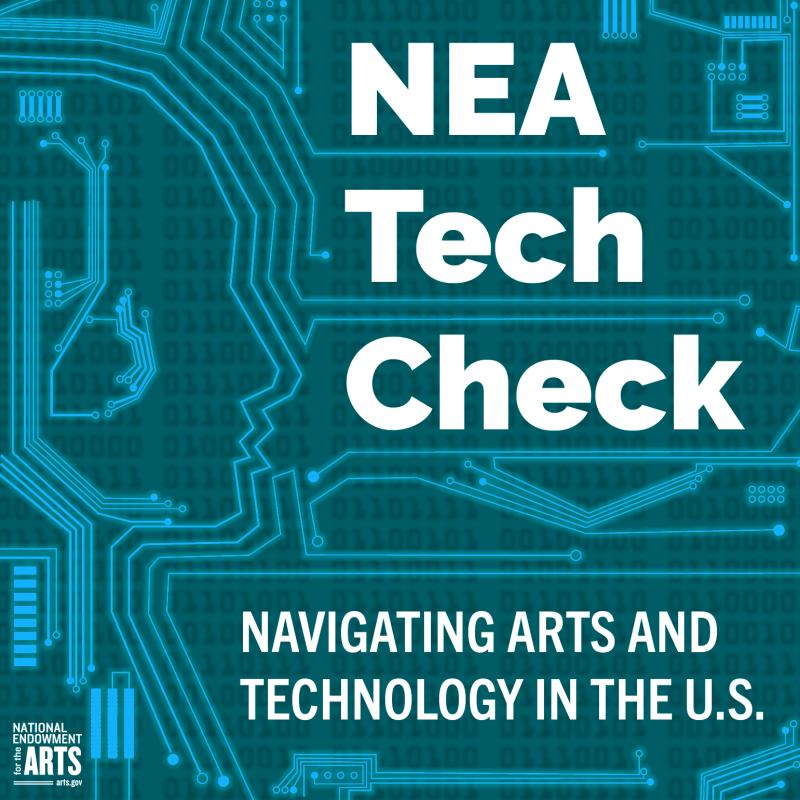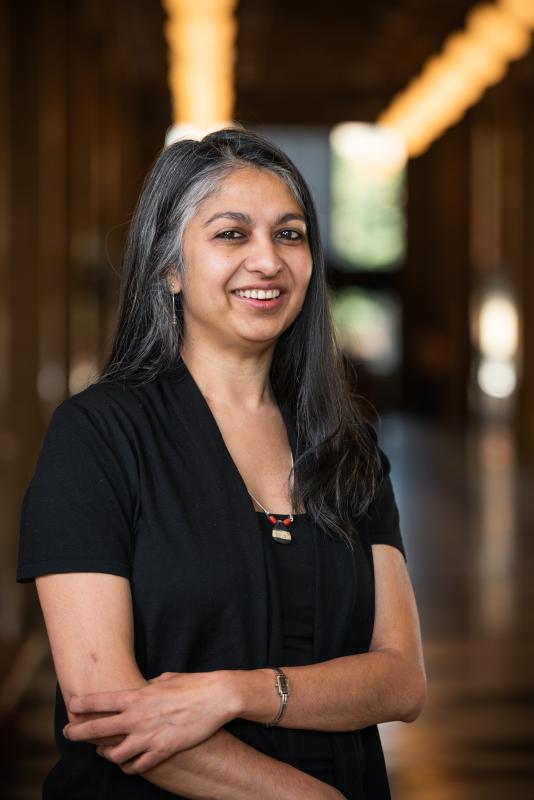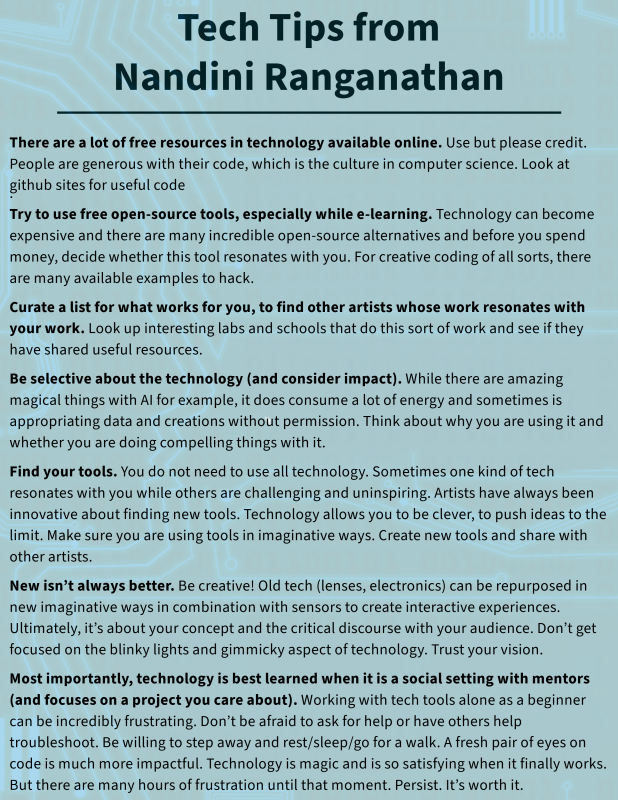NEA Tech Check: Nandini Ranganathan of CETI—A Creative and Emerging Technology Institute

This NEA interview series will take you on a journey across the nation to learn how leaders in the arts and cultural field are approaching the intersections of technology, culture, and society. Inspired by findings from the NEA arts and technology field scan conducted in partnership with Knight Foundation and Ford Foundation, we aim to increase public awareness of creative approaches to technology that engage local communities, explore ethical issues, and increase digital skills through the arts. Here is our conversation with Nandini Ranganathan, founder of CETI – A Creative and Emergent Technology Institute.

Nandini Ranganathan. Photo courtesy of CETI
NEA: Tell us about yourself.
NANDINI RANGANATHAN: I am the founder of CETI – A Creative and Emergent Technology Institute, a collective of artists, technologists, storytellers, researchers, and community members. My work involves bringing people together through the powerful tools of art, emerging technology, and storytelling to imagine and create inclusive, just futures.
Through CETI, I create interdisciplinary cross-sector convenings (collaborative creatathons, unconferences, design sprints, and festivals) around social, technological, and environmental challenges, and delight at the imaginative creations that emerge from unexpected collisions of people, practices, and ideas.
Community co-creation has been a theme in my personal work and my work at CETI, which has included a regional convening, Disinformation: A Call to Action, to gather and brainstorm strategies and tactics to creatively respond to disinformation focused on democracy, health, environment, and bigotry and violence; a Digital Privacy and Civic Data Policy Unconference that led to Portland’s facial Recognition ban; Citizen Science Projects to build environmental sensors, gather and interpret data; and a Wikipedia Editathon to include women and bipoc artists and scientist pages to Wikipedia.
(Editor’s note: Nandini was invited to do a TEDx Talk in 2019, which highlights more detail about her work around civic engagement and the power of community collaboration.)
NEA: How does your organization support artist-driven explorations of technology?
RANGANATHAN: This work is critical to our mission—building lifelong learning and rapid fluency and expertise amongst artists, designers, mediamakers to critically and creatively engage with the tools of emerging technology. Here are ways we support these explorations:
We have a cutting-edge emerging technology lab open to the community staffed by volunteer experts where anybody can come, explore the tech, experiment, get help with projects, get individual training;
We hold intensive Institutes focused on emerging tech, artificial intelligence (AI), interactivity, extended reality (XR), creative coding, Data storytelling, electronics and microcontrollers, projection mapping, 360 video, interactive sound, wearables, augmented storytelling;
Our annual Enchanted Technology Summer festival composed of workshops (beginning to advanced), innovative speakers, open lab time, and ending with hack days and a show;
An Annual CETI SPA (Spring Break Adventures in Technology) focused on a single theme; and
Regular weekend workshops and institutes in emerging technology
We believe that collaborative/informal peer learning and experiential learning are highly effective in building fluency and confidence in emerging technology. We hold regular creatathons and bring together a mixture of experts and beginners into our projects to foster this social experiential learning.
NEA: Why do you feel this work is important?
RANGANATHAN: We live in a world permeated by technology where technology impacts every part of our lives—our interactions, our decisions, our identities. Yet technology is controlled and created by a small homogenous group of people—mostly White men—with dangerous consequences. I strongly believe that more of us need the tools, confidence and skill to critically and creatively engage with technology as creators, as decision makers, to lead conversations, and to create things that have positive social and civic impact.
We believe that the lines between art, science, technology, and data are an artificial construct of the 20th century, and it is time for porous boundaries between fields, and that science and technology need to bring social and cultural context into their work. Artists are an important voice in this conversation, but often are intimidated by technology or are not empowered to speak or create work in this field. CETI’s mission and work is to build this fluency and this interdisciplinary conversation and network around emerging technology.
We know that technology and data can be powerful, and can be persuasive, and can be an incredible resource. It needs to be created by a diverse community that includes all stakeholders, and used with care for our communities, the planet, and the future. Emerging technology can be a powerful tool if wielded by artists, and bringing artists and creators into this space is essential.
CETI puts the power of emergent technology creation, innovation, and storytelling into the hands of communities that need it most, through collaborative learning, creativity, and invention, leading to a more joyful, prosperous, sustainable, and innovative commons.
NEA: How are you cultivating awareness of ethical issues and societal implications around technology? How are you exploring the impacts of artificial intelligence (AI) or advancing public’s awareness or understanding of the responsible use of AI in the field of arts—and why do you feel this is important?
RANGANATHAN: We address the implications and consequences of emerging technology in all our work.
Through informal conversations in the lab, on our community discord server and in our workshops, we regularly engage in critical conversations around the role of technology in the world. And we hold collaborative creatathons and shows focused around themes of technology in the world—privacy and surveillance, identity and agency in the age of AI, the role of creativity in AI, consumerism and capitalist systems, the impact of living in a smart connected world, etc.
Each participant creates work in response [to these different engagements] and we collectively generate conversations through our collective work. We also hold interdisciplinary generative design and ideation sessions, unconferences, and conferences encouraging the challenging of assumptions and limits, and exploring unforeseen consequences and harm through our work.
AI can be a powerful tool in the hands of artists, helping as a creative assistant similar to the sleight of digital tools artists have adopted. However, there are significant issues—energy use, environmental impact, issues of agency, and digital appropriation.
We want artists to not be afraid of this new tool, especially since it will become rapidly prevalent in film, video, digital illustration, and animation. We held a few pilot workshops this spring and hope to hold an institute next year. There are three areas of emphasis: skill/fluency-building, understanding issues and ethics, and also pushing these tools' creative limits while emphasizing social impact. We try to address all of this in our institutes, projects, and convenings.
NEA: What have been some reactions or memorable experiences through this work?
RANGANATHAN: CETI began during the pandemic and we wondered how to be; our work is so participatory and collaborative. We decided our first project was to reimagine future galleries. We built a gorgeous elaborate gallery complex (using a very new tool—Mozilla Hubs as an abandoned mall). Forty-two people collaborated in creating the space and we had over 35 artists from across the world “show” work in this complex as part of our Gallery of the Future exhibition: System Failure. Please Restart.
This exhibition took place as the world was transformed by pandemics and revolutions, as physical spaces, access, and connection were lost, and we were left to reimagine the gallery spaces of the future. This space was created by artists, technologists, and communities together—a space to collaboratively experiment, learn, play, engage, and create.
What we realized is that this process built new experts amongst the artists who went on to work on other incredible XR projects, built creative confidence, and empowered participants to collaborate across disciplines and sectors.
Similarly, in our XRchive projects [CETI’s collaborative XR storytelling project using immersive and interactive technologies] we see community members, technologists, and artists suddenly imagine more creative possibilities for these tools. Perhaps bringing archives to life in the streets or reimagining storytelling in museums. Or a group of Black elders whose property was destroyed by the city 50 years ago doing a historical recreation [using XR].
CETI also held a series of design sprints, creative artmaking, augmented storytelling and planning with Multnomah County's Office of Sustainability for a community XR project [funded by an NEA Our Town grant]. This was memorable because it allowed us to bring together municipal policymakers and researchers to see new ways of engaging communities (no more surveys!) and new ways of sharing results other than print reports and white papers, such as interactive web experiences and through XR—so that it brings in digital audiences as well.
Technology can be magical and powerful, and we are seeing our participants and partners and audiences be so excited imagining the wild possibilities when a broader group of people is empowered to use these tools.
NEA: Can you share examples of recent collaborations designed to bring together arts and technology across different sectors?
RANGANATHAN: CETI projects emphasize interdisciplinary creative experimentation and participatory research around emergent technology and social impact. They are intended to spark critical discourse bridging art, technology, and social/systemic change, revealing, subverting, and reimagining the implications and possibilities of these emergent technologies.
For all these projects, we are partnering with community groups, environmental groups, policymakers, municipal groups, researchers, artists, students, and technologists.
What has been challenging and inspiring is to recognize our role as a bridge and translator —fostering trust and dialogue across sectors and disciplines, with our projects and convenings acting as catalysts for imaginative innovations that emerge from unexpected collisions of people, practices, and ideas. There is shared purpose across these groups and once there is shared vocabulary and excitement around creating together, we have seen truly incredible creations.
I’d like to highlight two current successful ongoing projects (with almost complete prototypes):
Through CETI’s XRchive, our collaborative XR storytelling project, we use immersive and interactive technologies to create experiences, tours, and provocations in place around (hi)stories of migrations and displacements, injustice and racism, and future visions of Portland. Our first experience XRchive: (Hi)stories and Visions of Block 14 at Lone Fir Cemetery is an augmented storytelling project around the stories, culture, contributions, and history of the Chinese community buried at Block 14 at Lone Fir Cemetery. The people buried there were primarily Chinese immigrants and their families—laborers and railroad workers—whose role in building this city [Portland, OR] remains unacknowledged, whose communities were displaced, and stories were erased. Made in collaboration with a broad and diverse community of participants and partners, the interactive experiences created represents the fragmented memories of a collective of artists, technologists, storytellers, and community members, to tell the stories of these Chinese communities so integral to the creation of our city; to acknowledge, to remember, and to celebrate their contributions. Our collective work is a reflection, a remembrance, an XR (hi)storytelling and a joyful celebration of culture and rituals.
Postcards from Our Climate Resilient Future is an augmented placemaking project focused on environment justice, community health and climate resilience. The project visualizes community designed actions to address Multnomah County’s Climate Plan through a series of interactive dynamic artworks in situ (augmented murals, posters, postcards and artifacts) depicting imaginative, joyful and hopeful visions of a just climate future. The project brings voices and ideas of communities most impacted by environmental inequities and climate change to life in ways that are personal, poignant, powerful, and memorable, creating a storyscape accessible to all residents. Through Postcards from our Climate Resilient Future, CETI, Multnomah County, and our partners will share tactics and actions around the Climate Justice Plan, inspiring and mobilizing communities for environmental and social change.
NEA: How can small or mid-sized arts organizations get involved with this work, if coming to it for the first time? Why should they not feel intimidated, and how can they explore these tools/activities even on a modest budget or with more limited resources?
RANGANATHAN: The beautiful thing about emerging technology is that it is new to everybody, and rapidly changing. So, it is easy to become an expert and to bring in ideas. Nobody has a degree in any of this since much of what you learn becomes obsolete. What is needed is curiosity, a willingness to learn and experiment. It becomes about building confidence, trust, and a community you can learn and create with.
As part of our work, we record many of our workshops and add it to our CETI YouTube Channel to make it accessible for broader audiences. Use of the lab for experimentation and learning is free, and we make our workshops affordable and include trainings and one-on-one help.
Labs like CETI’s are a community resource as some of this technology is expensive. This sort of lab is like the Carnegie Library of the 21st Century—essential for learning, civic engagement, and creative innovation. We hope our work is a prototype for an ecosystem of such spaces nationally.

Nandini Ranganathan, Ph.D., is a creative sense-maker, convenor, and technologist, engaging communities to collaboratively wield the powerful tools of art, data, and emerging technology in participatory creation. She is the founder of CETI – A Creative and Emerging Technology Institute. She is also currently a Visiting Artist/Scholar in residence at Portland State University. Previously, she served as a Professor and Chair of Liberal Arts and Professor in Media Arts at Pacific Northwest College of Art, where she founded and directed Make+Think+Code, an art/technology/society lab.
Jax Deluca oversees the NEA’s grant portfolio and resources focused on supporting the diverse ecology of film and media arts ecosystems across the nation.





